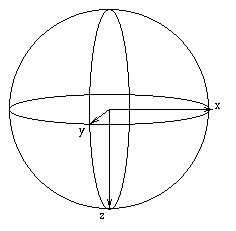
| rotational or azimuthal: | First rotation. | Around Z axis |
| tilting: | Second rotation. | Around new Y axis |
| psi: | Third rotation. | Around new Z axis |
All angles are measured using the left hand thumb rule (when aligning the left hand thumb with the rotation axis, positive angles are measured according to the direction of the rest of the fingers).
There is an approach which consists of rotating the volume according to the Euler angles and then projecting from Z-axis. An alternative one, and the one I have followed and found more practical is to move the view point (or better said the projection plane) according to the Euler Angles. Both ways will be explained here.
First, the way Xmipp define the coordinate axes is like this.

Getting Started
1)Construct a projection plane: take a little piece of paper and mark on it the image coordinate system will define the orientation of the projection. We will look the projection in the orientation just as it is shown.

2) Our point of view is defined just now for a little point on the bottom
of the sphere, while the projection plane is just on the opposite side.
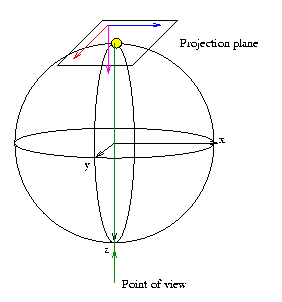
We begin now to read eulerian angles
3) TILT:
move the point of view as many degrees as necessary towards right (positive
tilting angles) or left (negative tilting angles). Projection plane must
move as if the system point_of_view-plane_of_projection were a whole.For
example, 90º of tilting would be
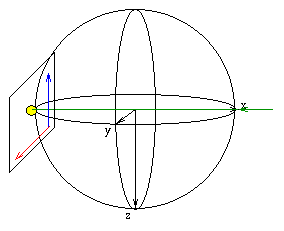
4) ROTATIONAL (AZIMUTHAL) ANGLE:
move the point of view towards you (positive azimuthal angles) or away
from you (negative azimuthal angles) (Notice that this directions
are simplifications for when tilting angles are positive, you must keep
in mind the direction of turn and not the description of towards or away
from you. If tilt angle is negative this directions are reversed in respect
to you but not in the direction of turn). For example from the above
situation of tilt=90, now let's take rotational=90. The new situation would
be
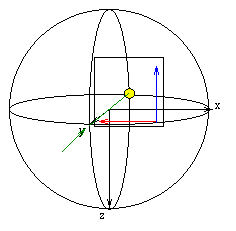
5) PSI:
for taking psi into account we must turn the projection plane together
with the point of view. Looking from the point of view positive psi angles
turns counterclockwise. For example, psi=90, would give,
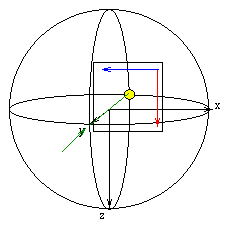
PROJECTING
Now we have to project the volume on the projection plane. As an example I have defined a volume which has got a sphere along y-axis, a larger ellipsoid along z-axis and a cylinder along x-axis as you can see in the next figure. If we project for (tilt=90, rot=90, psi=90) we would obtain the following by direct projection
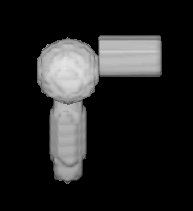
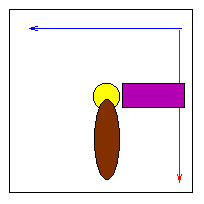
But as we know that our projection plane always has got its reference with X axis facing to the right and the Y axis looking down, we should rotate the projection obtained until it is well-referenced
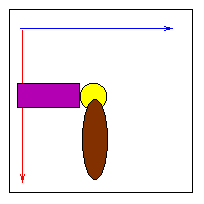

In the las figures we can check the consistency of this reasoning. The projection with tilt=90, rot=90, psi=90 has been taken with SPIDER. As we can see the results are identical.
PROJECTING in a more Euler fashion
So far we have devised a method to manually compute projections using a piece of paper and a fixed phantom. But this is not the way really they are taken. In this part we will move the phantom and letting the projection plane fixed. We start again from the same initial point as before. Now we will move the internal reference axes in the reverse order (click here for further information for why this is like that).
Starting Point:

3) PSI ANGLE
The rotational angle is the first Euler angle to measure, around Z. It is a left hand angle, so if the left hand thumb is aligned with Z then positive angles are measured in the direction of the rest of the fingers. We will develop the same example as before, so the new internal reference axes are
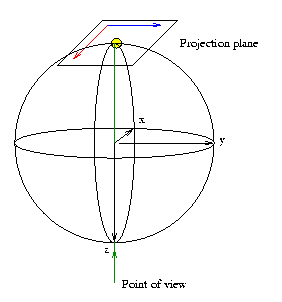
4) TILTING ANGLE
The tilting angle is a left handed turn around Y, but the new Y!!!. Applying tilt=90 in our example we get
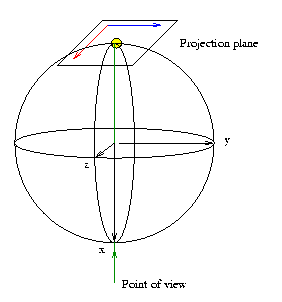
5) ROTATIONAL ANGLE
Finally the third angle is again a left handed turn around Z, again
the new one!!!. Using rot=90 we finally get
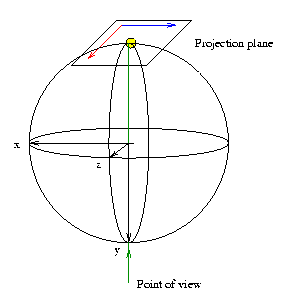
FACTS ABOUT THE EULER MATRIX and
SPIDER